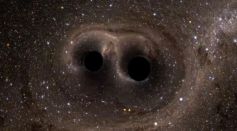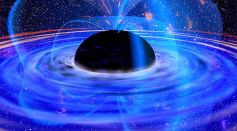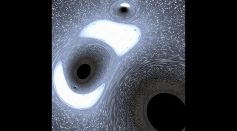Tags: Black Hole

Event Horizon Telescope Detects Strong Astrophysical Jet From Black Hole; What Is It Trying To Tell?
Neutron Stars Have Tiny Mountains That Are No More Than Millimeters Tall, Study Suggests
Gamma-Ray Bursts: What Do These Ultrabright Flashes Tell About the Universe?
Black Holes Might Have Hair, Study Says – Is Albert Einstein Wrong?
Are Black Holes Slowly Taking Over Star Cluster Palomar 5 Orbiting Milky Way Galaxy?

Did Scientists Just See A Black Hole Swallowing a Neutron Star for the 1st Time?

Supermassive Black Holes May Host the 'Largest Tsunami-Like' Structures, Experts Say
Tennis Ball Scale Primordial Black Holes: Will be Detected by a New Device Which Captures Gravitational Wave, Developed by Astrophysicists
Supermassive Black Holes Origins, Birth: How Dark Matter Halo Affect It
Sagittarius A* Might Not Be a Black Hole After All, Hints Toward Dark Matter Mass

Black Hole Plasma Beam Energy Emission Analyzed by Experts
Radio Blast From 13 Billion Years Away Detected; What Is It Trying To Tell Scientist?

Black Holes COULD Starve When Galactic Collisions Happen, Experts Say

Scientists Lay Down A Wild Plan to Harvest Energy From Black Hole

Astronomers May Have Heard the Possible Hints of Low-Frequency Gravitational Waves

Can Black Holes Ring Like a Bell? Here's What Astronomers Could Say
NASA's Hubble Space Telescope Shares "Cinnamon Bun" Galaxy

Ligo and Virgo Found New Weird Black Holes Teeming in the Universe
ESO Captures a Star Ripped Apart by a Black Hole
Exotic Peacocks of the Stellar World: A New Model for Colliding-Wind Binaries
Most Popular

Starlink Satellite Explodes in Orbit; SpaceX Confirms It'll Re-Enter Earth

Will Earth's Magnetic Poles Flip Next? Magnetic Pole Reversal Explained Through Cutting‑Edge Magnetosphere Science

What Causes Monsoons? How Seasonal Winds Shifts and Climate Patterns Drive Rainfall

How Lightning Science Reveals Why Charged Storms Are Rising with Global Warming Effects




